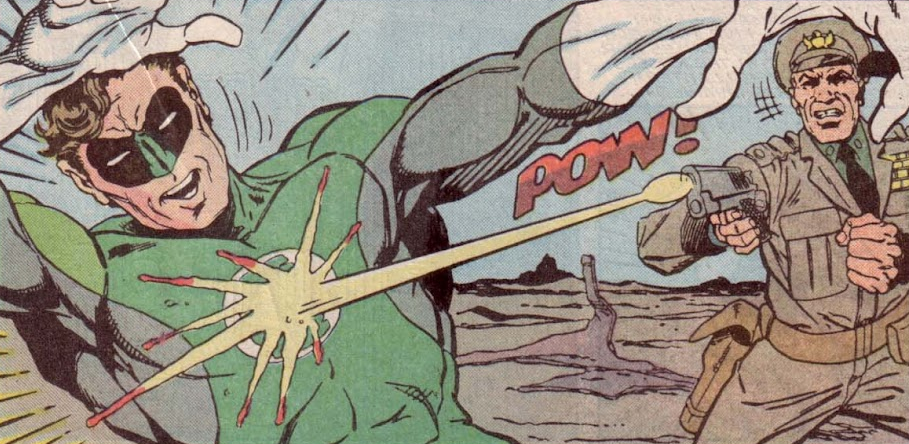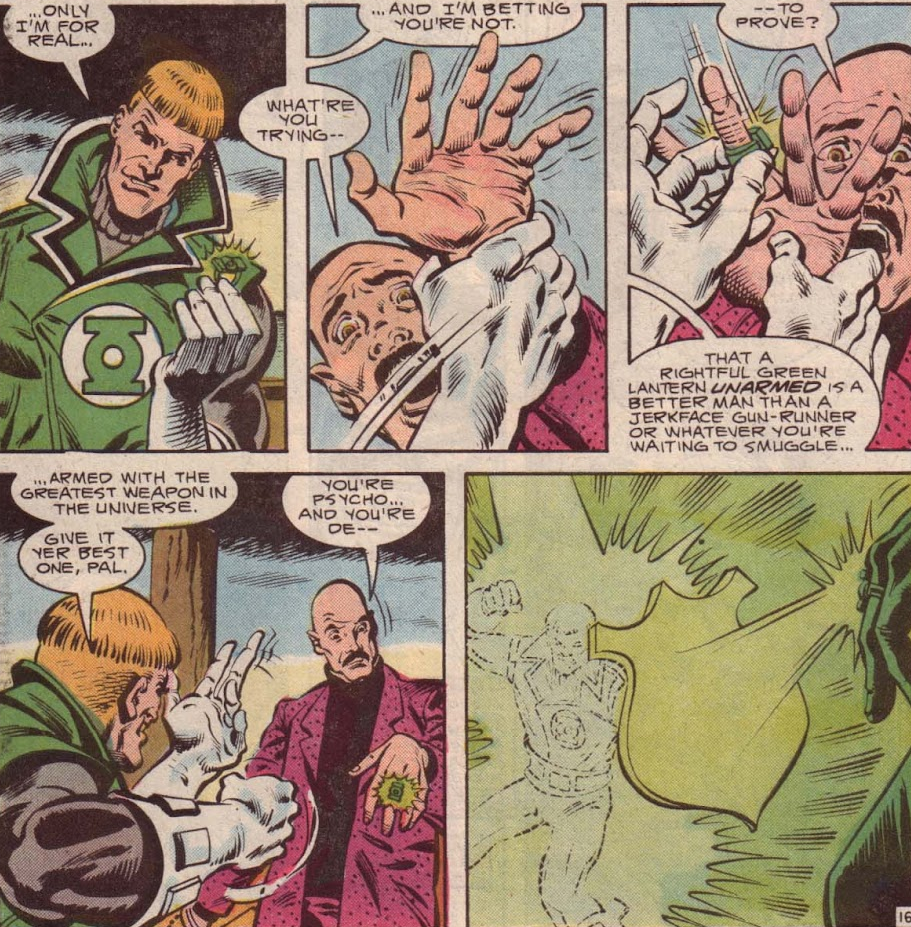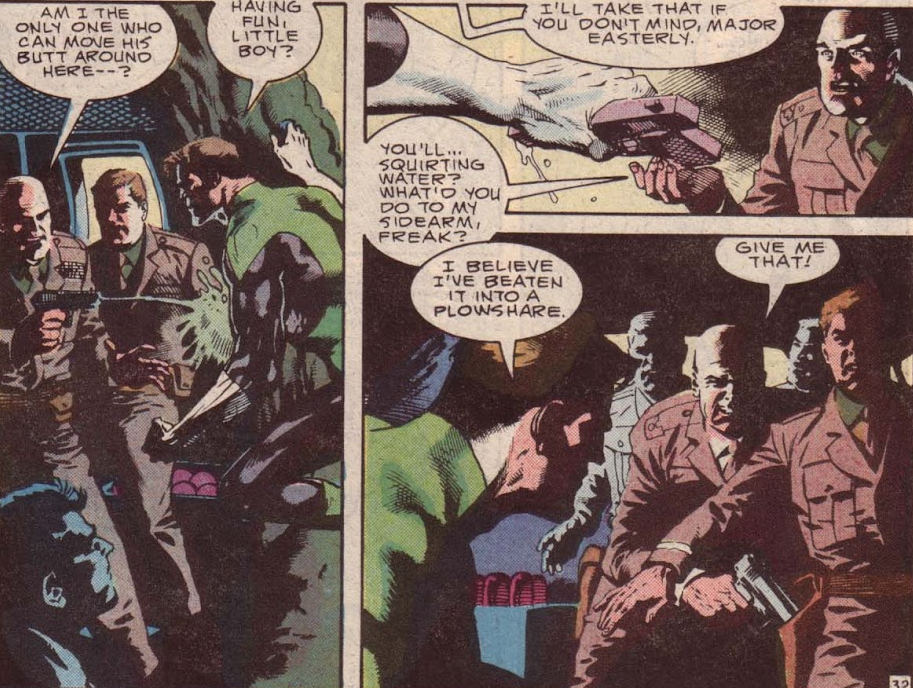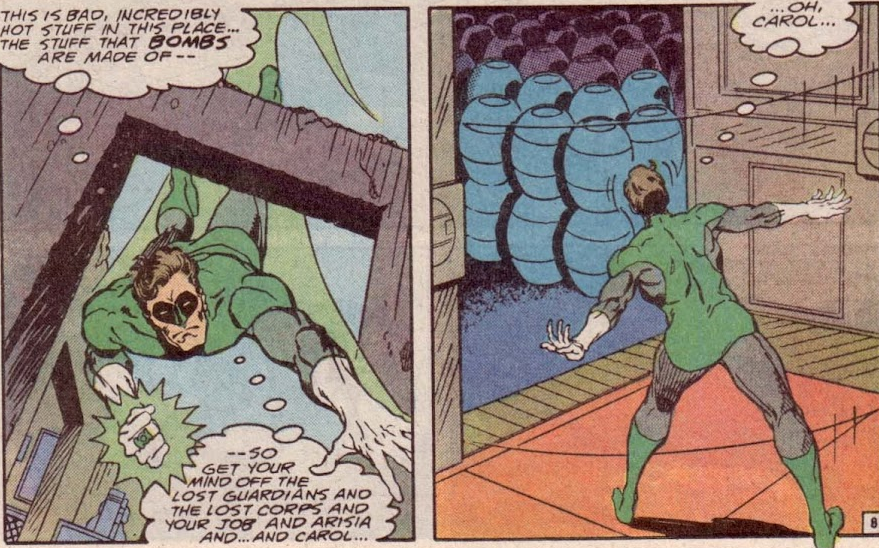Action Comics Weekly #642 (March 1989)

Action Comics Weekly #642 (March 1989)
Superman gets offered a job as a Green Lant– hey, wait a minute, why are we back in 1989?! Is Zero Hour already messing with the timestream? Nah, it’s because, while making a Superman ‘86 to '99 reading guide at League of Comic Geeks, I noticed we never covered this issue – we have a post about the Superman serial in Action Comics Weekly #601-641, and one about the classic Action Comics (Non-Weekly) #643, but this one sorta fell through the cracks since it wasn’t technically part of the serial but not really a monthly issue either. So, with present-day Action Comics going weekly again this month, it seems like a good time to right another long-time wrong and plug this tiny hole in the '86-'99 continuity.
Anyway, the issue starts with a flashback to the day Green Lantern Abin Sur crashed down on Earth and, in his dying moments, instructed his ring to select and bring over a successor, who ends up being… Clark Kent?

Yep, this issue reveals that Clark was Abin’s first choice for Earth’s Green Lantern – and no, this doesn’t take place in some alternate timeline, like that annual where Superman becomes GL and President of the USA. However, the ring soon determines that Clark doesn’t qualify for the gig because he’s from a species “not native” to this planet, even though Man of Steel #1 established that he was born on Earth. Still, I guess it wouldn’t be good for his GL authority to be undermined by any potential birther movements. Before having his memory of the incident wiped by the ring, Clark sees a projection of the other GL candidates, which include Robin, someone who looks like Pope John Paul II, and a test pilot Clark remembers interviewing called Hal Jordan. (Oh, and no women, leading Clark to correctly deduce that Abin’s bosses have “an attitude problem.”)

Clark recommends Hal for the job because he’s “the straightest arrow I ever met” and will surely never go insane and kill a bunch of his buddies. Great call, Clark.
Meanwhile, in the present (well, 1989’s present), Hal Jordan returns to that same desert where he first became Green Lantern to investigate a bunch of stolen nuclear materials someone’s been piling up here. Some military types start shooting at Hal, which wouldn’t normally be a problem for a Green Lantern, except that Hal is feeling so insecure lately that his ring malfunctions and lets the bullets hit him. When an army major shows up and starts barking orders, Hal just lets the guy arrest him and ends up getting shot in the chest by him. Again: great call, Clark.

As Hal lays dying in the desert, his ring is like “whelp, here we go again” and goes looking for potential Green Lantern candidates from all over the planet. They are: a union leader at an Eastern European factory, a priest in South Africa, an old Native American guy who fights mountain lions, a hostage negotiator in Beirut, Nightwing (so Robin again, but all grown up), Deadman (currently possessing some criminal), and Guy Gardner. Doesn’t Guy already have a GL ring? Nope, because he just gave it to some very confused arms dealer who looks like G. Gordon Liddy to make a fight more interesting.

Oh, and Clark Kent again. Wasn’t Clark already disqualified from the job? You’d think the ring would keep track of stuff like that.
As Hal’s ring-projected ghost looks over his potential replacements, who are frozen in time at the desert, Deadman is able to talk to him (being a ghost too) and tries to convince him to just let himself die and go to heaven, where he can chill with Abe Lincoln, Ghandi, MLK, Robin Hood, and some unicorns. Clark unfreezes himself in time and tells Hal he should continue living, his main argument being “What if you miss out on the exciting space exploration that’s definitely happening in the next decades?” (which is kind of a weird thing to say to a guy who can fly through space on his own).

Clark and Deadman get so caught up in their argument that they don’t even notice an AI version of Abin Sur coming out of the ring and joining their little ghost party. “Abin” tells Hal that all of these other candidates are “lesser wills” compared to him, which surprises Hal (wonder if he heard “lesser willies”). Apparently that’s what gives Hal the confidence to go back to his body, instantly heal himself, go kick those military dudes’ butts, and convince a judge to prosecute them. While Hal’s doing all that, we see that every one of the potential candidates took some GL energy with them as they got transported back to their countries and unknowingly used it to deal with the sticky situations they were in, from “convincing a factory boss to hire an old man back” to “declawing and defanging a mountain lion.”
As for Deadman, he possesses the body of a kid from Clark’s building just to continue his life/death argument with him. Clark tries to ignore him as he walks through Metropolis, but Deadman keeps jumping from body to body (a doorman, an old lady walking a dog, the dog) to pester him. Clark refuses to take the bait…

…until Deadman goes away, proving that Superman’s will may not be as big as Hal’s, but at least it’s bigger than this guy’s.
Creator-Watch:
Unless you count the Kingdom Come novelization, this was the only Post-Crisis Superman story written by prolific Pre-Crisis writer Elliot S! Maggin, who wrote over a hundred Action, Superman, and Superman Family issues in the '70s and early '80s. This is also, not coincidentally, the only Post-Crisis Superman story that ends with this Clark offering his once-customary last panel wink at the reader, though nothing we’ve seen so far suggested that fourth wall-breaking winks was in his power set. Maybe he just saw Bibbo across the street?
Plotline-Watch:
The “ACTION - CLOSED FOR RENOVATION” sign up there is a reference to the ads DC used to hype up the Action Comics Weekly series in 1988, which showed a theater marquee with messages like “WATCH FOR GRAND OPENING” and “GALA PREMIERE.” Ending with “RENOVATION” is appropriate, since the regular Action title wouldn’t be back for three more months.
The retcon about Clark helping Abin Sur pick Hal Jordan as Green Lantern means that, in a roundabout way, Superman is responsible for all those deaths in “Emerald Twilight” and certain dramatic events we’re about to see all over the DC Universe. So, if you think about it, this issue is connected to the Zero Hour coverage we’ve been promising for some time now…
When Clark and Deadman are arguing about whether Hal should live or die, Deadman says one shouldn’t “screw around with the way things go” (meaning: you can’t just go back to life if you already died). Clark says “I resent that.” I’m guessing he resents it even more post-Doomsday.

The stuff about Hal feeling fearful and insecure is explained in his ACW serial, but it’s interesting that it lines up with the future retcon about a certain space parasite crawling up his butt sometime around this period. His next appearance would be in the rebooted Green Lantern #1 (1990), which is the issue where his hair started going grey (due to the fear caused by the aforementioned space bug, it was later revealed).
Don Sparrow says: “This issue, which was supposed to wrap up a number of the anthology of storylines depicted in Action Comics Weekly (or just feature the players within the book) was actually the second attempt at a final issue. The first attempt was written by Neil Gaiman, but was deemed unsuitable since his story relied on Superman and Hal Jordan knowing each other’s civilian identities, which was an editorial no-no at the time. So the story that Gaiman – fresh off Black Orchid at the time, but before he’d hit it big with Sandman – wrote went on a shelf, eventually emerging as a one-shot prestige format book which was released 11 years later. Though it had its moments, that story also felt similarly disjointed, to me at least, and the art styles from each chapter clashed even more jarringly than this issue. But at least that’s the last controversy Neil Gaiman was ever involved with.” (Who’s gonna tell Don?) I remember kinda liking that one. Since it came out in 2000, it’s outside the scope of this blog, but maybe we’ll cover it at the newsletter and Patreon at some point anyway.
Shout Outs-Watch:
Speaking of which, massive Hal Jordan’s willforce-sized shout outs to our supporters, Aaron, Chris “Ace” Hendrix, britneyspearsatemyshorts, Patrick D. Ryall, Bheki Latha, Mark Syp, Ryan Bush, Raphael Fischer, Kit, Sam, Bol, Dave Shevlin, and Dave Blosser! You can join them at those links above, because we feel self-conscious enough about plugging them once already.
And now, Don’s take on this issue, plus more art from the stacked roster of artists (including Steve Ditko and Kevin Nowlan)!
Art-Watch (by @donsparrow):
Starting with the cover, and it’s a strange one. I absolutely adore Ross Andru generally, so, not knowing if it’s the inks or the pencils, both the drawing and colouring here seems pretty rushed. The image of Superman weighing the Green Lantern uniform is a good concept, and would have made a decent panel, but it seems a little under-developed for a proper cover. Add to that the fact that only some of the crowd behind Nightwing, Deadman and Superman are familiar, and there’s a strange weightlessness to Nightwing’s stance, and it just doesn’t feel like what I’m used to seeing from Ross Andru.
Inside the book though, we open with an absolute treat, with the opening pages drawn by the instantly identifiable Gil Kane. This is late period Kane, and while it’s not as sharp as his drool-worthy early Green Lantern or Spider-Man runs, his late, ligne claire style is still a joy to read. It’s especially wonderful that these early pages are right in his wheelhouse with a lot of space technology—Kane did practical-seeming high-tech buttons, panels and wires about as good as anyone. It’s fascinating seeing the visuals of the other candidates Abin Sur’s ring seeks out—to my eye that looked like Pope John Paul II (I guess the ring, nor the writers of this comic could see that he wasn’t entirely honest, or without fear), Dick Grayson (who I mistook for Jason Todd because of the haircut), John Stewart, and then Hal on the far right. I wasn’t sure, on my first reading just who the mustachioed fellow is between Stewart and Jordan—Hector Hammond I thought. So I was glad the stories in later chapters elucidated these images. [Max: Worth noting that it’s mentioned John Stewart wasn’t invited to the latter part of the story because he was off-planet, not because the ring has something against architects. Also, they say the white priest is dead by then, so that can’t be John Paul II unless 1981 went very differently for him in this universe…]
If I dare criticize someone with a legendary career, I was a bit thrown by how frequently Kane draws Clark with a prominent (and very Superman-like) S-curl in his hair, jeopardizing his secret identity. Then again, he recognizes the alien is dying, so maybe he’s deduced it’s ok to be a little careless with the forelock.

After Kane’s brief story, we’re treated to another rarity for its time—mainstream comic pages from Steve Ditko! Being fairly familiar with his style in the 80s, I’d say Art Thibert (future super-teamster, lending a very Jim Lee aesthetic to Dan Jurgens lines in the early '90s) has a pretty heavy hand here, as Ditko’s pencils, while always energetic and succinct, had gotten a little looser by the late 80s. No matter who is more responsible for the images we see, there’s a great sense of movement and imagination to these pages, especially Hal’s use of his ring. Battering rams we’ve seen before (even in Superman comics, wherein Hal may or may not look so totalled it makes Superboy wanna hurl) but making a dragon creature to simultaneously capture armed guards and excavate a roof is pretty darn inventive. I also appreciate Ditko’s pure cartooning—this is certainly a more visibly expressive Green Lantern than we’re used to seeing, so it’s bold to have the character emote a little more.

The Curt Swan pages that follow are unsurprisingly excellent, Ty Templeton’s precise inks making them look all the more crisp (if memory serves, Templeton was a sharpie marker guy as well!) but they don’t give Swan a lot to do, drawing lots of real world, civilians in clothing type storytelling. Don’t get me wrong, Swan can do it all, but this glacial, decidedly non-superhero interval gives a hint to me as to why Action Comics Weekly kinda sputtered out. Though it’s perhaps a dull scene (Clark typing out a story on a computer), the rendering and lighting of the panel of Superman using his visual powers is almost photographic, it looks so good. The Deadman section has a bonkers depiction of Heaven, complete with Abraham Lincoln, Mahatma Gandhi, Jesus Himself (!), Robert, Earl of Huntingdon (AKA Robin Hood) and Dr. Martin Luther King Jr, with Deadman assuring a ghostly Hal Jordan that Lincoln is the funny one in the group. [Max: Wait, is that Jesus? I thought it was Uncle Sam without the hat, or maybe a time-displace Lex Luthor Jr.]

A few pages later we get a great look at Hal Jordan diving into a spiral caused by helicopter blades, and as often happens with Kevin Nowlan, the penciller underneath, no less than Carmine Infantino, gets a little lost—not that I’m complaining—I love Kevin Nowlan’s sometimes overpowering inks, because they’re so clean and delicate. [Max: Side note: Why do all the guns in this issue look like water pistols squirting green liquid?]

The Nightwing section is Jim Aparo at his reliable best, though the inks by Nyberg look a little dated next to the more modern finishes of Nowlan.
SPEEDING BULLETS:
Fun, but tragic fact—the consistent line weight of Gil Kane’s self-inked pages (like the ones in this book) were largely created by non-archival alcohol or xylene based markers, so a lot of Kane’s original art from around this period yellowed so significantly over time that some of his pages feature ink “blacks” that are light yellow on white, making those beautiful creations almost invisible. Fortunately, having looked into it, these very pages still look pretty good today.
I like that even back in 1988, Clark Kent is evolved enough to question why Sur’s ring didn’t find any female candidates.
While it’s fun to explore the function of Hal’s ring, I don’t know if I subscribe to the notion that his shield would be that weak if he had a confused thought.
I like oldies enough that I can’t help hearing Neil Sedaka’s high pitched tones as I read Hal thinking “Oh, Carol!”

On the whole, I found this whole yarn, about military corruption, with the brief if colourful interstitials to introduce the other Lantern candidates (which had little bearing on the rest of the story) pretty hard to follow. Even more so, since we don’t actually see the fruits of Green Lantern’s labour—Major Easterly isn’t shown being arrested, we see only the signing of the warrant for his arrest, which feels like something more consequential than the kid selling door to door in Clark’s apartment building, say.
Action Comics Weekly was an interesting experiment, and there’s a pretty in-depth explanation of DC’s reasoning behind discontinuing it. They do acknowledge that sales weren’t strong, but also posit that they weren’t at cancellation level. Their rationale for cancellation was that the weekly schedule was too difficult to keep up with, especially with a double sized book like Action Comics Weekly. I remember being incredibly excited when it was first announced, then crushed when I realized that Superman got only two pages in each issue. Yes, the story was by Roger Stern, and yes, illustrated by Curt Swan, so we were in good hands, but there was a dullness and a lack of fantasy or superhero action in the stories that persisted, and made ACW feel less than essential. The teams were top notch talents (people like Mark waid, Peter David, Dave Gibbons, Christopher Priest, etc). The characters were ones I wanted to read about, but what happened in the stories often felt like strange choices. For example, there was an extended Hal Jordan story where it was revealed that Hal Jordan, whose only thing is that he’s honest and fearless was revealed to be neither honest, nor fearless, but had been subconsciously purged of fear and dishonesty by his ring, requiring him to deprogram the ring to remove that influence. That decision led to reading about Hal Jordan cowering on the ledges of buildings, afraid to fly as he got his bravery back. Interesting concept, or intellectual exercise, perhaps, but is it what the average Green Lantern fan would want to read? It felt like there was a lot of that to me (though it did have the unique element of depicting Oprah Winfrey threatening to break…something… of Green Lantern’s). Once Roger Stern was brought on as a regular writer, some elements (like the Superman cult of California) were a little more integrated into continuity, but for the most part as a Superman fan at the time, the ACW story read a lot like pre-Crisis Superman.
Missed an issue? Looking for an old storyline? Check out our new chronological issue index!
This newsletter is free and always will be, but if you'd like to support us with $1 a month or more, you'll get access to extra articles about non-continuity '90s Superman stuff (shows, video games, Elseworlds, etc) and cool giveaways. Click here to become a paid supporter!
Add a comment: